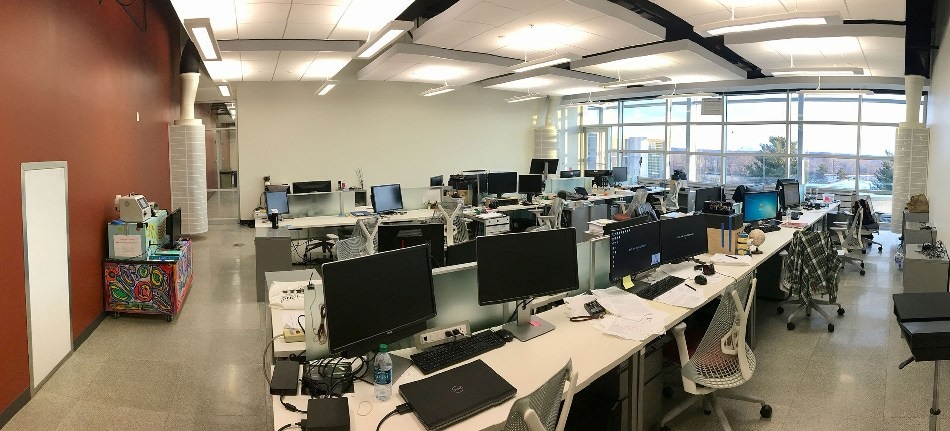Oct 4 2019
According to a growing body of evidence, merely by wearing deodorant or breathing, a person may have more impact over his/her office space than previously thought.
 A study in a tightly controlled office space at Purdue University is showing that people greatly impact the air chemistry of the rooms where they work. (Image credit: Purdue University photo/Brandon Boor)
A study in a tightly controlled office space at Purdue University is showing that people greatly impact the air chemistry of the rooms where they work. (Image credit: Purdue University photo/Brandon Boor)
To learn more, engineers at Purdue University have been performing one of the largest studies of its kind in the office spaces of a building fitted with thousands of sensors. The goal is to detect all kinds of indoor air contaminants and suggest ways to control them through how a building is constructed and managed.
If we want to provide better air quality for office workers to improve their productivity, it is important to first understand what’s in the air and what factors influence the emissions and removal of pollutants.
Brandon Boor, Assistant Professor of Civil Engineering, Purdue University
Boor also has a courtesy appointment in environmental and ecological engineering.
The data reveals that people and ventilation systems significantly impact the chemistry of indoor air—perhaps more than any other factor in an office space. The scientists will present their preliminary findings at the 2019 American Association for Aerosol Research Conference in Portland, Oregon, from October 14th to 18th.
“The chemistry of indoor air is dynamic. It changes throughout the day based on outdoor conditions, how the ventilation system operates and occupancy patterns in the office,” stated Boor.
The building, named as the Living Labs at Purdue’s Ray W. Herrick Laboratories, utilizes a collection of sensors to accurately monitor four open-plan office spaces and to track the flow of outdoor and indoor air via the ventilation system. The team formulated a new method to monitor occupancy by inserting temperature sensors in each desk chair.
By using the Living Labs, Boor’s team has started identifying previously unidentified behaviors of chemicals known as volatile organic compounds, such as how they are changed in ventilation systems and eliminated by filters.
We wanted to shed light on the behind-the-scenes role ventilation systems have on the air we breathe.
Brandon Boor, Assistant Professor of Civil Engineering, Purdue University
Boor collaborated with scientists at RJ Lee Group to deploy a very sensitive “nose”—an instrument that researchers refer to as a proton transfer reaction time-of-flight mass spectrometer.
The instrument, normally used for measuring outdoor air quality, assisted in “sniffing” out compounds in human breath, such as isoprene, in real time. Boor’s team learned that isoprene and many other volatile compounds remain in the office even after people are no longer present in the room.
More number of people in a room also means additional emissions of these compounds.
Our preliminary results suggest that people are the dominant source of volatile organic compounds in a modern office environment. We found levels of many compounds to be 10 to 20 times higher indoors than outdoors. If an office space is not properly ventilated, these volatile compounds may adversely affect worker health and productivity.
Brandon Boor, Assistant Professor of Civil Engineering, Purdue University
The team also showed that a pollutant entering from outside, ozone, vanishes inside. This is because ozone interacts with other indoor compounds and the huge surfaces of a furnished office.
The scientists learned that ozone and compounds emitted from peeling an orange, called monoterpenes, mix to develop new, super-tiny particles as small as one-billionth of a meter. The newly formed particles could be deadly as they are quite small and can enter into the deepest areas of the lungs of a person.
The effects of volatile compounds discharged in an office might not just be limited to indoors. The scientists believe that chemicals produced from self-care products such as makeup, deodorant, and hair spray may raise levels outdoors as they are emitted outside by the ventilation system.
This work is sponsored partly by the Alfred P. Sloan Foundation Chemistry of Indoor Environments Program, the National Science Foundation Environmental Engineering Program, and the Purdue Research Foundation.
The study aligns with Purdue’s Giant Leaps celebration, recognizing the university’s worldwide advancements made in sustainability and health as part of Purdue’s 150th anniversary. These are two of the four subjects of the yearlong celebration’s Ideas Festival, planned to showcase Purdue as an intellectual center solving everyday problems.
Indoor Air Quality Research in Purdue's Living Labs
(Video credit: Purdue University)